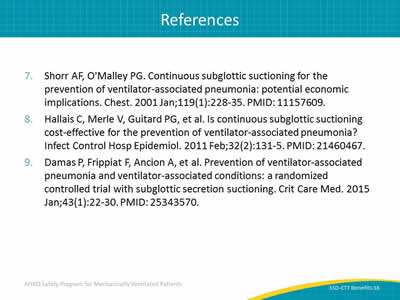Benefits of Subglottic Secretion Drainage Endotracheal Tubes: Facilitator Guide
AHRQ Safety Program for Mechanically Ventilated Patients
Slide 1: Benefits of Subglottic Secretion Drainage Endotracheal Tubes
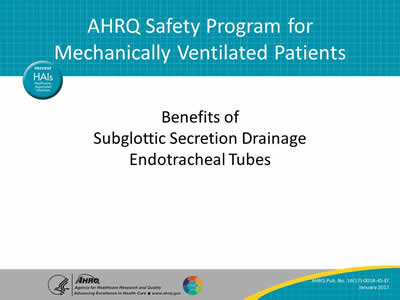
Say:
In this module, you will learn about the benefits of subglottic secretion drainage endotracheal tubes, or SSD-ETT.
Slide 2: Learning Objectives
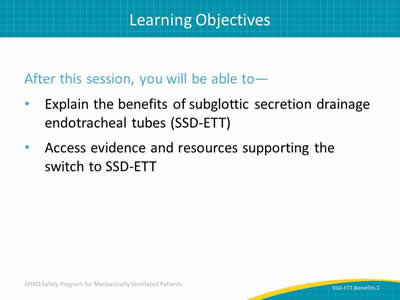
Say:
After this session, you will be able to explain the benefits of SDD-ETT as well as access evidence and resources supporting the switch to SSD-ETT.
Slide 3: Flaws With Early Endotracheal Tubes
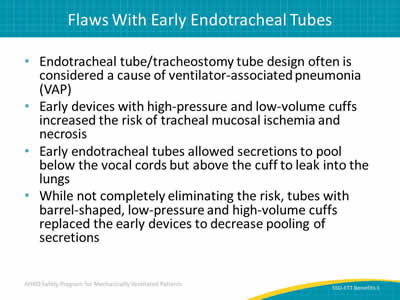
Say:
The design of endotracheal and tracheostomy tubes is often considered a cause of ventilator-associated pneumonia, or VAP. Early endotracheal and tracheostomy tubes used high-pressure and low-volume cuffs, which increased the patient’s risk of tracheal mucosal ischemia and necrosis. The design of these tubes allowed secretions to pool below the vocal cords and above the cuff, ultimately leaking into the lungs and increasing the risk of VAP. These early devices were replaced with tubes with barrel-shaped, low-pressure and high-volume cuffs, which, while not completely eliminating the pooling of secretions, helped decrease the risk.
Slide 4: SSD-ETTs
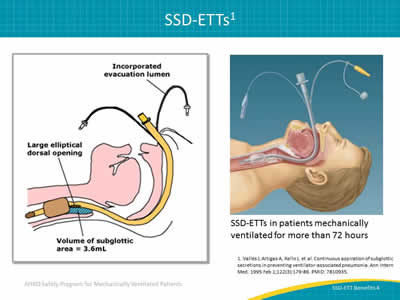
Say:
Newer endotracheal tubes, SDD-ETTs, have a small hole at the rear of the tube and above the cuff. A channel runs up inside the endotracheal tube and is connected to a suction port to remove secretions and prevent bacteria accumulation.
Slide 5: SSD-ETT Specific VAP Prevention Guidelines
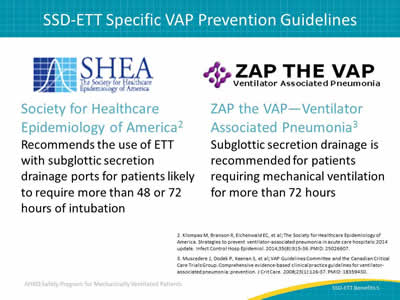
Say:
Evidence shows that an SSD-ETT can significantly reduce the need for mechanical ventilation, patient risk for ventilator associated pneumonia or VAP, and time spent in the intensive-care unit or ICU. These organizations recommend that these endotracheal tubes should be provided for mechanically ventilated patients who are likely to need an endotracheal tube for more than 72 hours.
Slide 6: SSD-ETT Specific VAP Prevention Guidelines
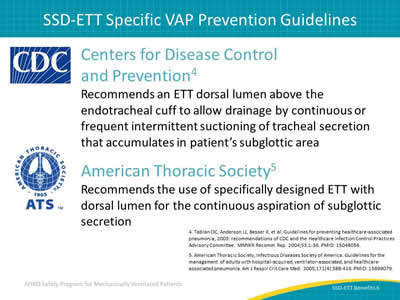
Say:
These organizations also recommend that ETTs should have a dorsal lumen to drain tracheal secretions from the patient’s subglottic area.
Slide 7: SSD-ETTs—More Recent Evidence
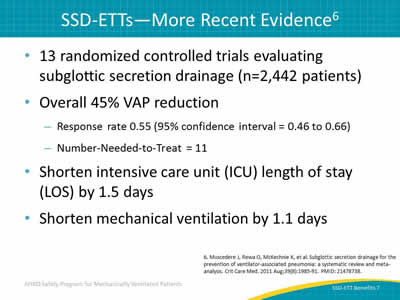
Say:
A systematic review and meta-analysis of 13 randomized controlled trials evaluated subglottic secretion drainage in 2,442 patients. Overall, implementing SSD-ETTs caused a 45 percent VAP reduction, shortened patient length of stay in ICUs by 1.5 days, and shortened the length of mechanical ventilation necessary for patients by 1.1 days. The review also demonstrated that using SSD-ETT had no effect on adverse events or on hospital or ICU mortality.
Slide 8: SSD-ETT—Cost Effectiveness Analyses
![Shorr et al. states, 'Regular utilization of [closed suction system] CSS-ETs may produce significant cost savings, irrespective of the increased costs of CSS-ETs.' Hallais et al. states, 'CSS was cost-effective even when assuming the most pessimistic scenario of VAP incidence and costs.'](/sites/default/files/wysiwyg/professionals/quality-patient-safety/hais/tools/mvp/modules/technical/subglottic/subglottic-slide8.jpg)
Ask:
Are SSD-ETTs cost effective?
Say:
While SSD-ETTs are more expensive than standard endotracheal tubes, they are certainly cost effective in their ability to prevent VAP and the costs associated with it. Research by Hallais et al. on the cost-benefit analysis of replacing conventional ventilation with continuous subglottic suctioning showed that even when assuming the most pessimistic scenario of VAP incidence and costs, implementing SSD-ETT was still more cost effective than conventional methods.
Slide 9: Subglottic Suctioning Study
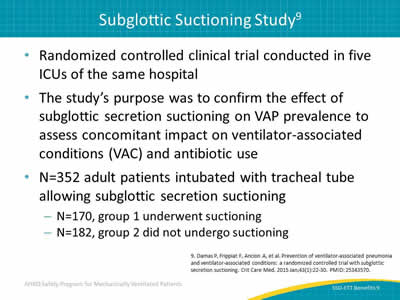
Say:
A randomized controlled clinical trial was conducted in five ICUs of the same hospital. This trial was used to confirm the effect subglottic secretion suctioning had on VAP prevalence as well as other ventilator-associated conditions, or VAC, and antibiotic use. In this study, 352 adult patients were intubated with tracheal tubes that allowed subglottic secretion suctioning. These adult patients were split into two groups. The first group, comprising 170 patients, actually underwent the suctioning process while the remaining 182 patients of the second group did not.
Slide 10: Results of Subglottic Suctioning Study
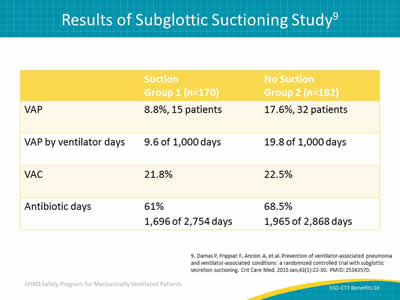
Say:
After the study was completed, patients in the subglottic suctioning group demonstrated significant improvement through the use of the subglottic suctioning.
Of this group, 8.8 percent, or 15 of those 170 patients, developed VAP. However, 17.6 percent of patients in the nonsuction group—32 of those 182 patients—developed VAP. This is more than twice the amount of patients who developed VAP after subglottic suctioning.
Suctioning also cut VAP by ventilator days in half, from 19.8 days for patients who did not receive suctioning to 9.6 days for those who did. The daily use of antibiotics also significantly decreased for patients in the first group by 269 days less than those in the second group.
Overall, VAC did not undergo much change. However, it is important to consider that the Centers for Disease Control and Prevention’s definition of a VAC includes conditions that are not necessarily related to infection, such as atelectasis and mucous plugging.
Slide 11: Impact of Subglottic Secretion Suctioning
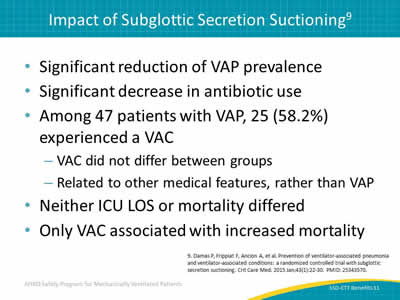
Say:
SSD-ETTs have demonstrated a significant reduction of VAP prevalence as well as a decrease in the need for antibiotic use. Among the 47 total patients with VAP, 25 of those patients experienced a VAC. VAC did not significantly differ between groups and most conditions were related to other medical features, rather than VAP itself. Neither ICU length of stay or mortality differed. Only VAC was associated with increased mortality.
Slide 12: Strategy
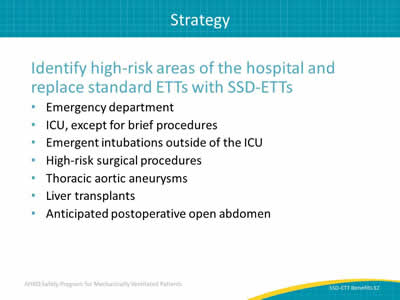
Say:
A recommended strategy is to identify high-risk areas and replace standard ETTs with SSD-ETTs for patients in the emergency room, the ICU with the exception of brief procedures, emergent intubations outside of the ICU, and patients involved in high-risk surgical procedures such as thoracic aortic aneurysm repair, liver transplants, as well as those with an anticipated postoperative open abdomen.
Slide 13: Resources—Fast Facts
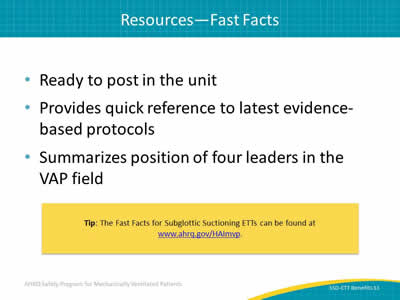
Say:
The AHRQ Safety Program for Mechanically Ventilated Patients provides many tangible resources you can use to educate and reinforce SSD-ETT protocols. A Fast Facts guide for SSD-ETTs is ready to be posted in your unit. It provides a quick reference to the latest evidence-based protocols as well as summarizes the position of four important leaders in the VAP field. This document can be found on the AHRQ Web site.
Slide 14: Resources—Literature Synopsis
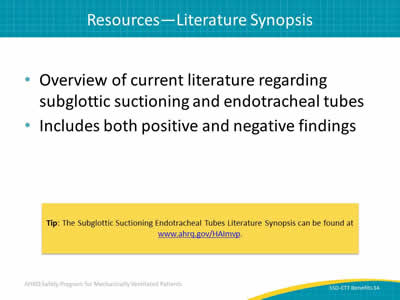
Say:
The SSD-ETT Literature Synopsis is also available on the AHRQ Web site and provides an overview of the current literature regarding subglottic suctioning and endotracheal tubes, including both positive and negative findings.
Slide 15: Questions?

Slide 16: References
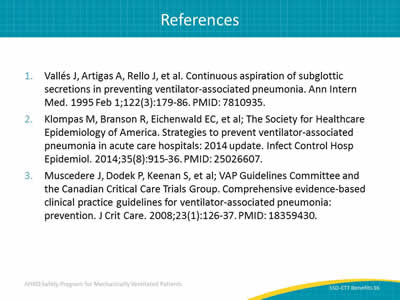
Slide 17: References
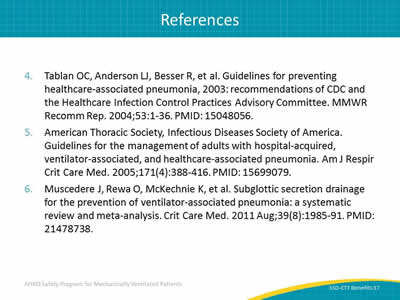
Slide 18: References
